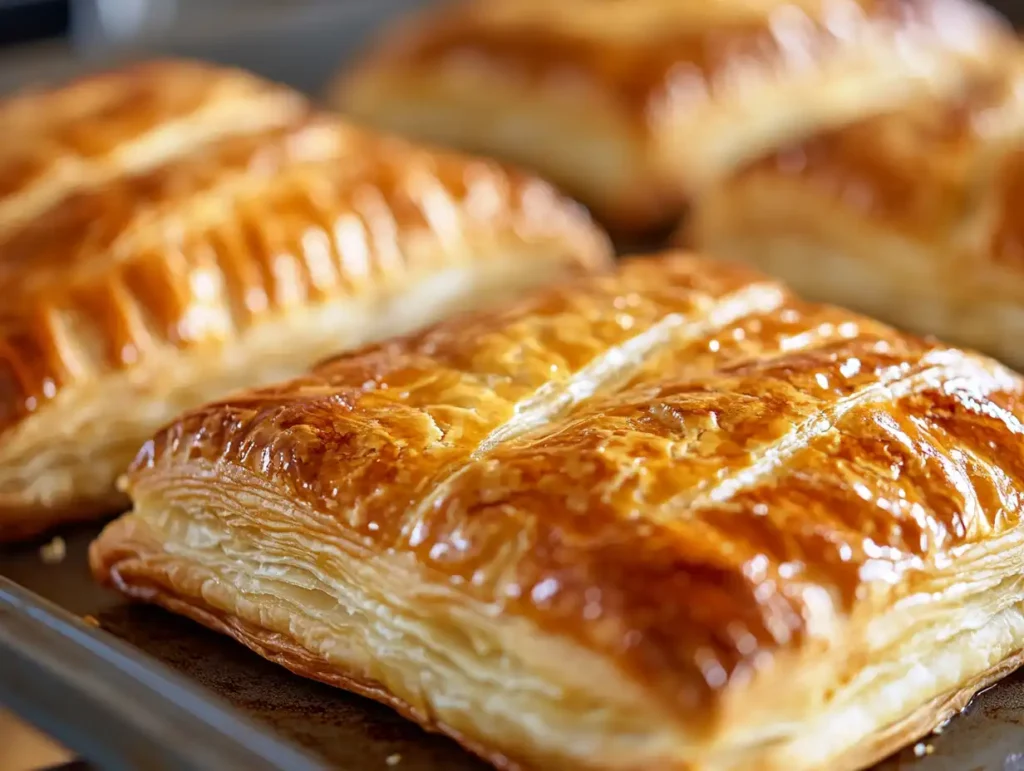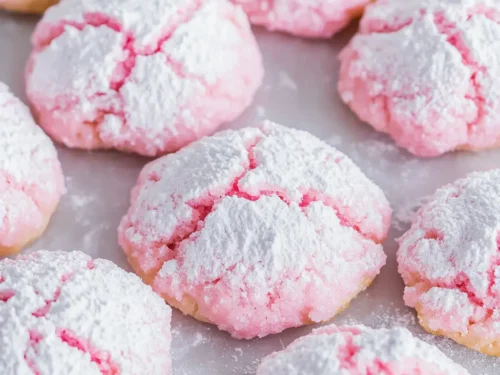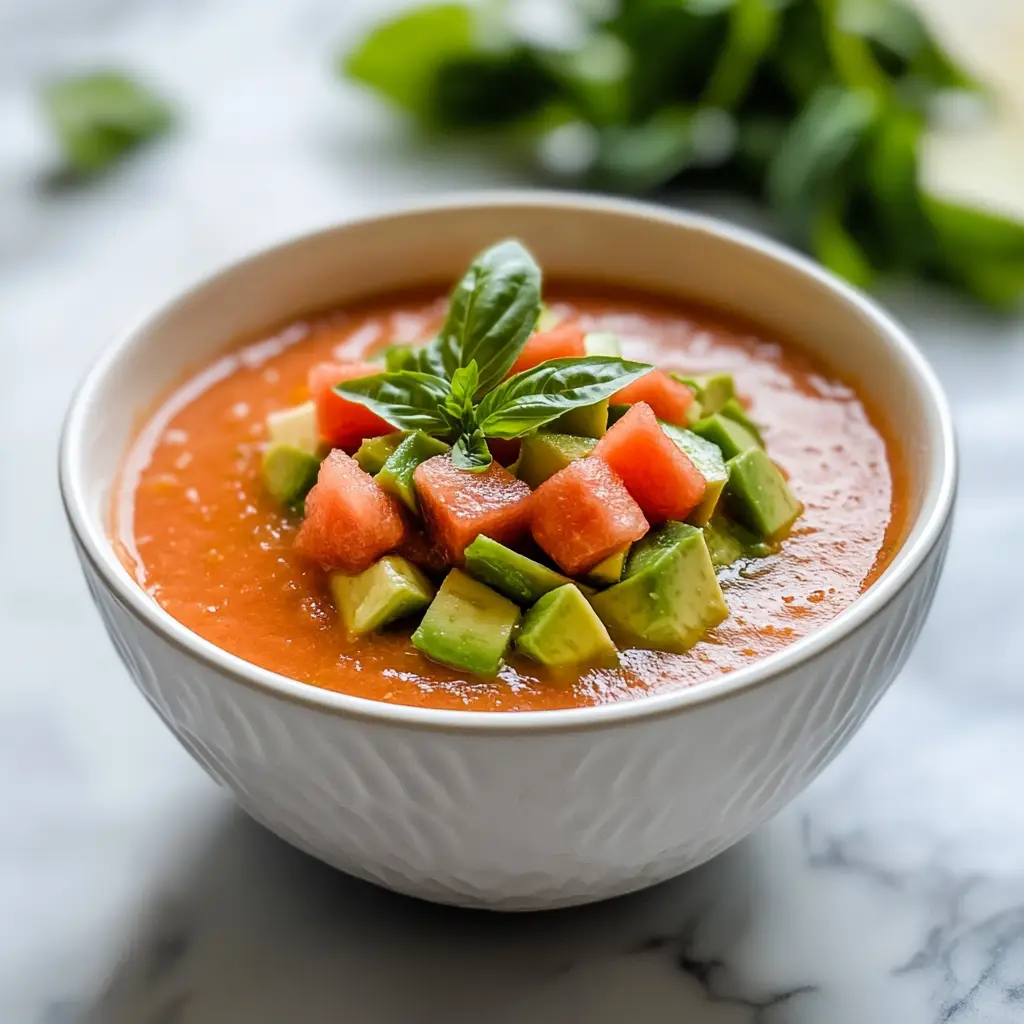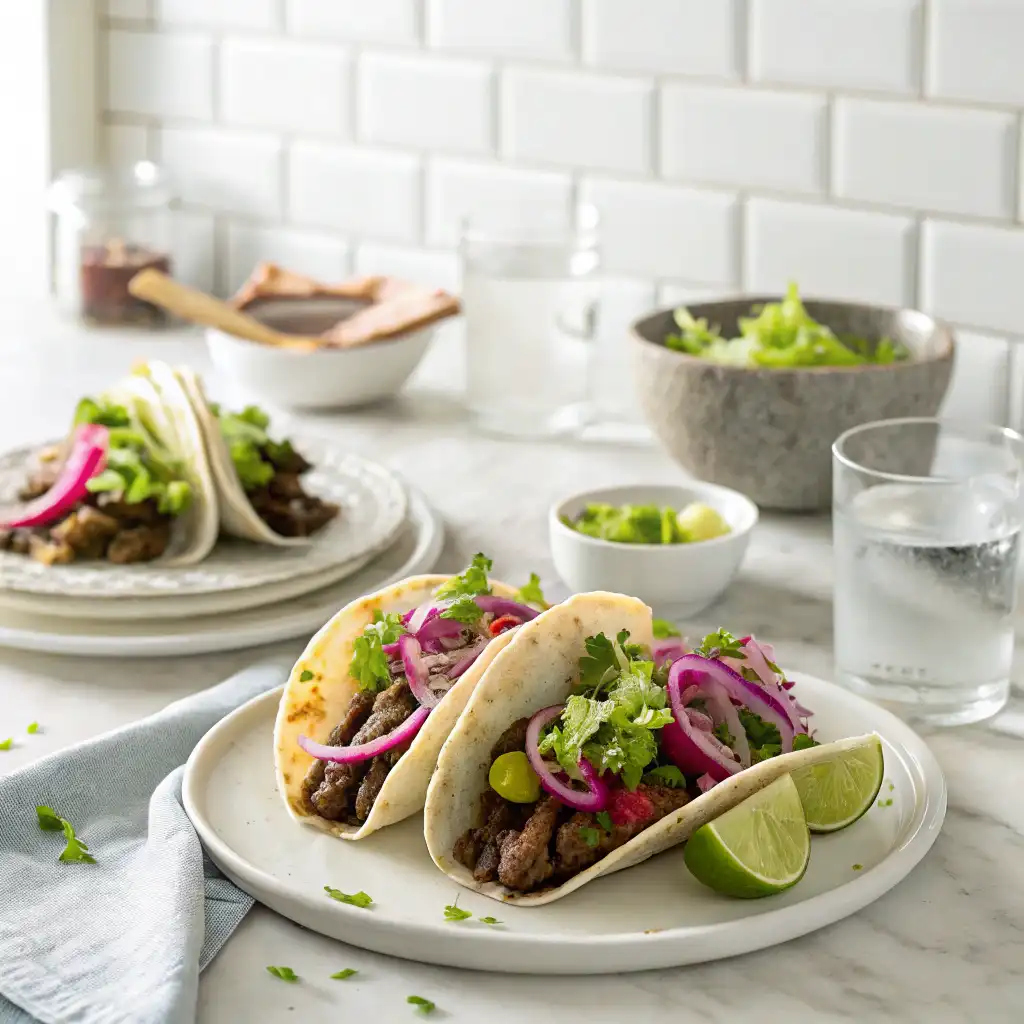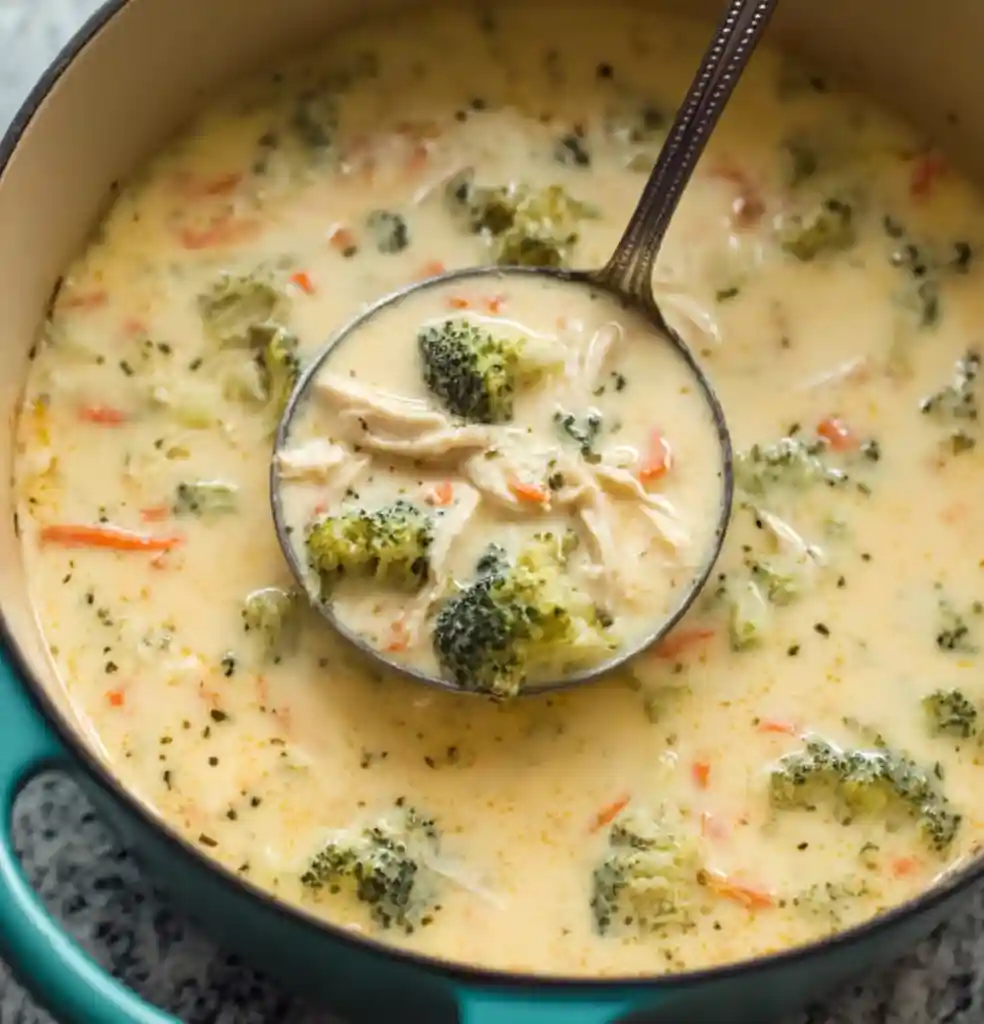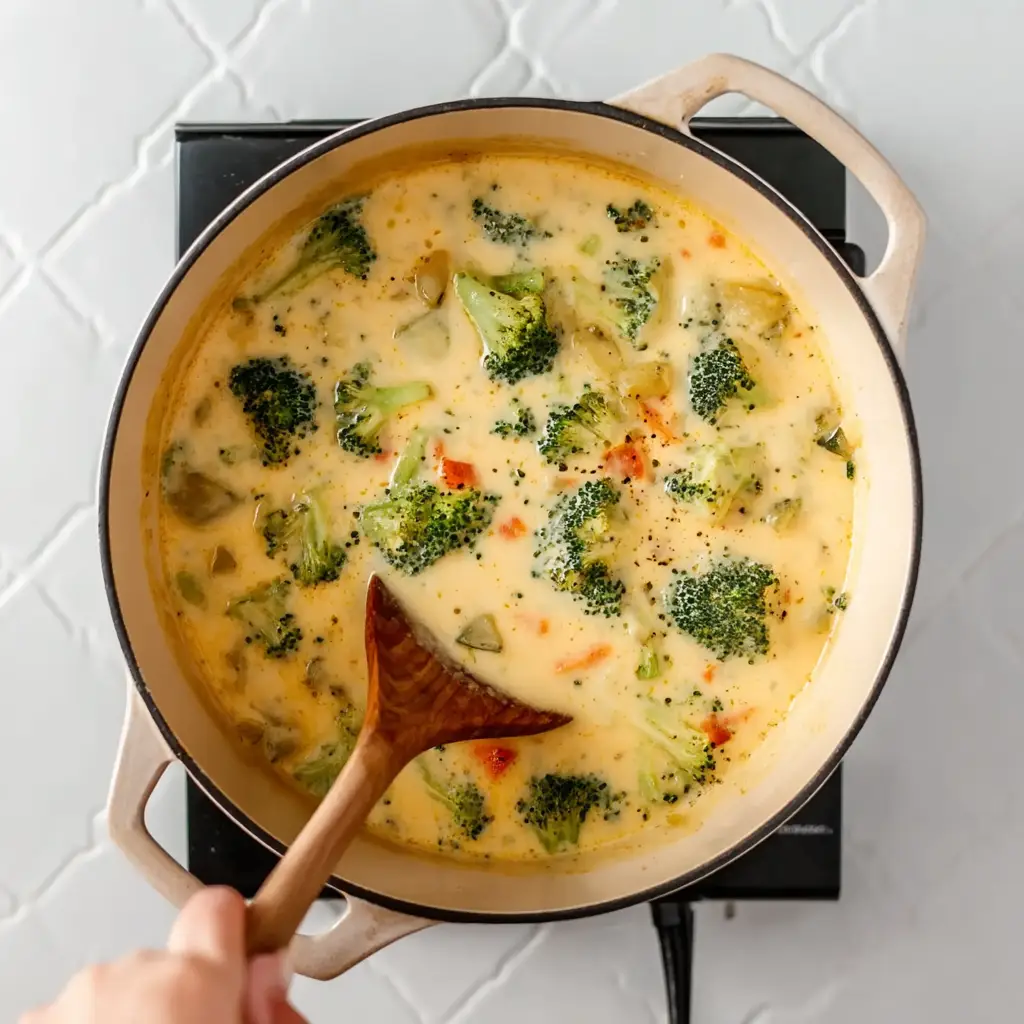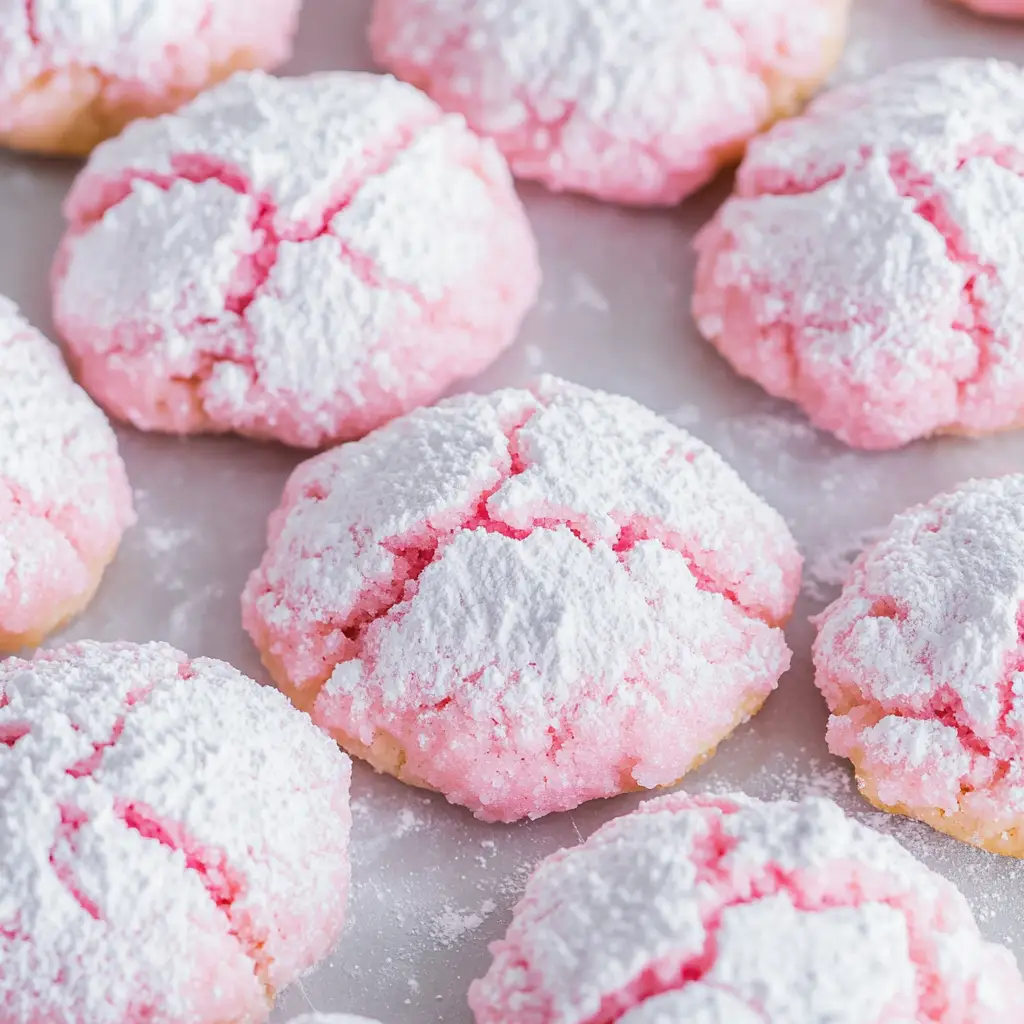If you’ve ever wondered what temperature to cook puff pastry, you’re not alone! Achieving that perfect golden, flaky texture depends on getting the temperature just right. Too low, and your pastry won’t puff properly-too high, and you risk burning the outer layers while leaving the inside raw.
In this guide, we’ll break down the best baking temperatures, common mistakes to avoid, and pro tips to ensure your puff pastry turns out crispy, light, and delicious every time!
📌 If you’re looking for creative ways to enjoy puff pastry in the morning, explore these Puff Pastry Breakfast Recipes for delicious ideas like sweet turnovers and savory mini quiches!
Table of Contents
Understanding Puff Pastry: What It Is & Why Temperature Matters
The Importance of Puff Pastry Baking Temperature
The secret to perfect puff pastry? It’s all in the temperature! Get it right, and you’ll enjoy crispy, golden layers with a light, airy center.
Mastering oven temperature is key-not just for pastry! If you love perfectly crisp textures, check out this guide on Perfect Roasted Potatoes for extra tips.
What is Puff Pastry?
Puff pastry is a delicate, multi-layered dough made by folding butter between layers of flour and water. When baked, the butter melts and releases steam, creating the light, flaky layers that make puff pastry so irresistible.
🍽️ Perfect for:
✔️ Sweet treats like croissants and danishes
✔️ Savory dishes like cheese-filled tarts & appetizersVegetarian Soup Ideas may inspire your next meal.
The Science Behind Perfect Puff Pastry Layers
What makes puff pastry rise? It all comes down to three key factors:
🔥 Butter Layers – As the pastry bakes, the butter melts and produces steam, lifting and separating the dough layers.
💪 Gluten Structure – The gluten in the flour gives the dough strength, helping it hold its shape as it expands.
🌟 Caramelization – A properly heated oven ensures the outer layers crisp up beautifully, giving that golden, flaky finish.
🔹 Bottom Line? Get the temperature right, and you’ll get perfectly puffed pastry every time!
Best Baking Temperatures for Flaky Puff Pastry
The Ideal Temperature Range
For the best results, bake puff pastry at 375°F to 425°F (190°C to 220°C).
| Baking Temperature | Best For |
|---|---|
| 375°F (190°C) | Gentle rise, avoids over-browning (great for sweet pastries) |
| 400°F (200°C) | Standard temperature for most recipes |
| 425°F (220°C) | Crispier texture, ideal for savory puff pastry dishes |
Optimal Cooking Temperature
Finding the Right Heat for Perfect Puff Pastry
Bake puff pastry at 375°F to 425°F (190°C to 220°C) for consistent results. Lower temperatures may result in dense layers, while higher temperatures can lead to overbrowning. For tips on balancing flavors, try pairing puff pastry with the techniques from this Breakfast Pizza Recipe.
What’s the Best Oven Setting for Puff Pastry?
For most recipes, preheating your oven to 400°F (200°C) is ideal. This ensures your pastry rises beautifully, creating that golden, flaky texture. Trust me, taking a few extra minutes to preheat your oven makes all the difference!
Factors That Affect Puff Pastry Baking Temperature
The best temperature for your puff pastry depends on several factors:
✔ Recipe Type – Some pastries require lower heat (delicate desserts), while others need higher heat (savory pies).
✔ Oven Type – Convection ovens circulate air, requiring a lower temperature than conventional ovens.
✔ Pastry Size – Small appetizers need higher heat, while larger pastries bake better at a slightly lower temperature.
✔ Filling Moisture – Wet fillings (like fruit or cheese) may require a lower baking temperature to prevent soggy bottoms.
Temperature Adjustments for Sweet vs. Savory Puff Pastry
- Savory Puff Pastry Dishes: Dishes like puff pastry tarts, pies, or appetizers often benefit from baking at the higher end of the temperature range, around 400°F to 425°F (200°C to 220°C). This helps ensure the pastry becomes crisp and sturdy enough to hold the savory fillings.
- Sweet Puff Pastry Dishes: For desserts like turnovers or palmiers, a slightly lower temperature around 375°F to 400°F (190°C to 200°C) may be preferable to prevent caramelized sugar from burning and to achieve an evenly golden crust.
Fine-tuning the temperature to suit the specific recipe and oven type can elevate the quality of your puff pastry creations, delivering a delectable balance of texture, flavor, and visual appeal.
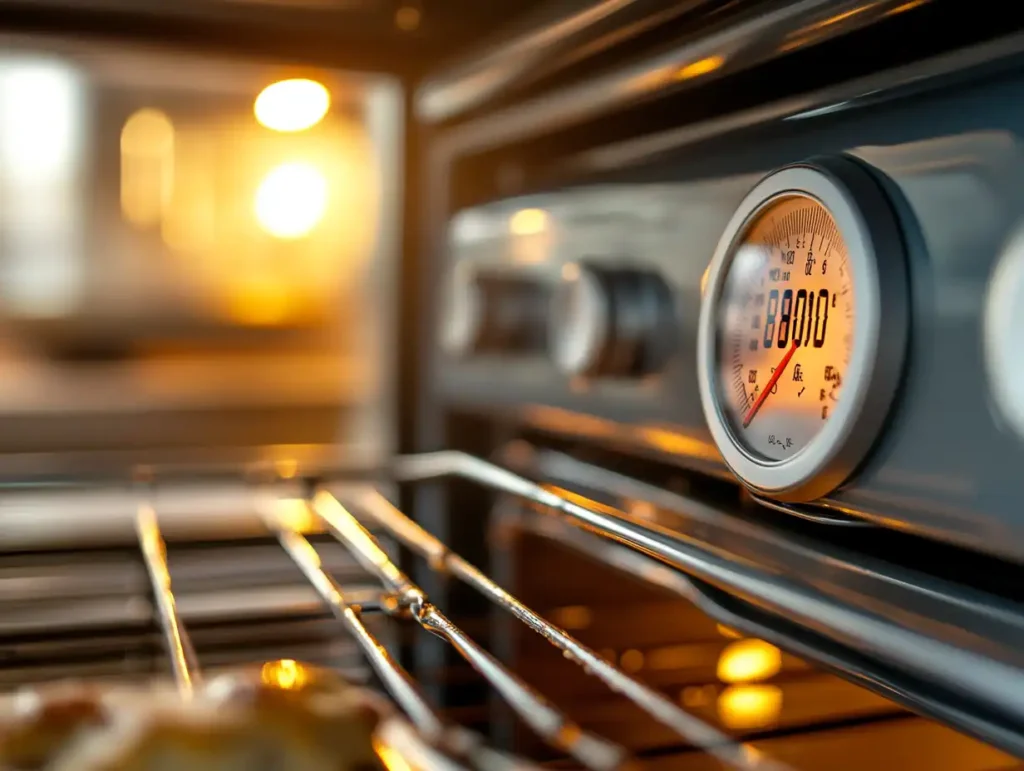
Baking Puff Pastry: Step-by-Step Guide
1️⃣ Preparing Puff Pastry for Baking
🔹 Thawing & Handling
- If using frozen puff pastry, thaw it in the fridge overnight.
- Keep the dough cold-warm pastry won’t puff properly.
🔹 Rolling & Cutting
- Use a floured surface to roll out the dough gently.
- Avoid pressing too hard-this keeps the layers intact.
2️⃣ Preheating the Oven
Always preheat your oven! A hot oven ensures the butter in the dough melts quickly, creating steam for that perfect rise.
⏳ Preheat Time: Allow 10-15 minutes for the oven to reach 375°F-425°F.
3️⃣ Lining & Arranging Puff Pastry on the Baking Shee
- Use parchment paper or a silicone baking mat to prevent sticking.
- Space pastries at least 1-2 inches apart so they don’t merge while baking.
- Pro Tip: Chill the baking sheet with the arranged pastry for 10 minutes before baking-this enhances puffing.
Monitoring the Baking Process
Signs Your Puff Pastry is Baked Perfectly
✔ Even Puffing – Layers should be well-defined and crisp.
✔ Golden Color – A warm, golden-brown hue means the pastry is fully cooked.
✔ Crispy Texture – The outside should be flaky, while the inside is light and airy.
Mid-Bake Adjustments (If Needed!)
🔄 Rotate the Pan – If your oven has hot spots, rotate the tray halfway through baking for even cooking.
🔥 Lower the Temperature – If the pastry is browning too quickly, reduce the heat by 15-25°F and bake slightly longer.
⏳ Check Frequently – Keep an eye on the last few minutes to prevent overbaking.
Cooking in Different Types of Ovens
Convection Ovens vs. Conventional Ovens
- Convection Ovens:
- How They Work: Convection ovens use a fan to circulate hot air, providing even heat distribution.
- Advantages for Puff Pastry: These ovens are excellent for baking puff pastry because the circulating air ensures even browning and promotes a consistent rise.
- Temperature Adjustment: Convection ovens typically require reducing the temperature by 25°F (15°C) compared to recipes designed for conventional ovens. For example, if the recipe calls for 400°F in a conventional oven, set the convection oven to 375°F.
- Cooking Time: Baking times may also be slightly shorter in convection ovens, so monitor the pastry closely to avoid overcooking.
- Conventional Ovens:
- How They Work: Conventional ovens rely on radiant heat from the top and bottom elements.
- Challenges for Puff Pastry: Hot spots and uneven heat distribution are more common in conventional ovens, which can lead to uneven browning or puffing.
- Temperature Consistency: Preheating the oven thoroughly is crucial for success, as placing the pastry in a cold or unevenly heated oven can compromise its rise.
Troubleshooting Uneven Baking
- Issue: Uneven Puffing or Rising
- Cause: Uneven heat distribution or improper handling of the dough.
- Solution:
- Rotate the baking sheet halfway through the baking time.
- Ensure the dough is rolled out evenly and avoid pressing too hard.
- Keep the pastry cold before baking, as warm dough can rise unevenly.
- Issue: Overbrowned Edges with Undercooked Centers
- Cause: The oven temperature may be too high, or the pastry pieces are too thick.
- Solution:
- Lower the oven temperature by 15-25°F and extend the baking time slightly to allow the centers to cook through.
- Roll the pastry to the recommended thickness for the recipe.
- Issue: Soggy Bottoms
- Cause: Insufficient oven heat or using a heavily moistened filling.
- Solution:
- Use a preheated baking sheet or place the pastry on a wire rack to allow heat to circulate underneath.
- Avoid overloading the pastry with wet fillings.
- Issue: Uneven Browning
- Cause: Hot spots in the oven or inconsistent placement on the rack.
- Solution:
- Place the baking sheet in the center of the oven for even exposure to heat.
- Use an oven thermometer to check for temperature accuracy.
Understanding the nuances of your oven and making adjustments as needed will help you overcome common challenges and bake puff pastry with consistent, professional-quality results.
Common Puff Pastry Mistakes & How to Fix Them
| Mistake | Solution |
|---|---|
| Underbaked pastry (raw inside) | Bake at a slightly higher temperature and ensure the oven is fully preheated. |
| Burnt edges, raw center | Lower the heat by 15°F-25°F and extend the baking time. |
| Soggy bottom | Use a preheated baking sheet and avoid overloading with wet fillings. |
| Pastry didn’t rise | Keep dough cold before baking and avoid handling too much. |
Tips for Enhancing Puff Pastry Flavor and Texture
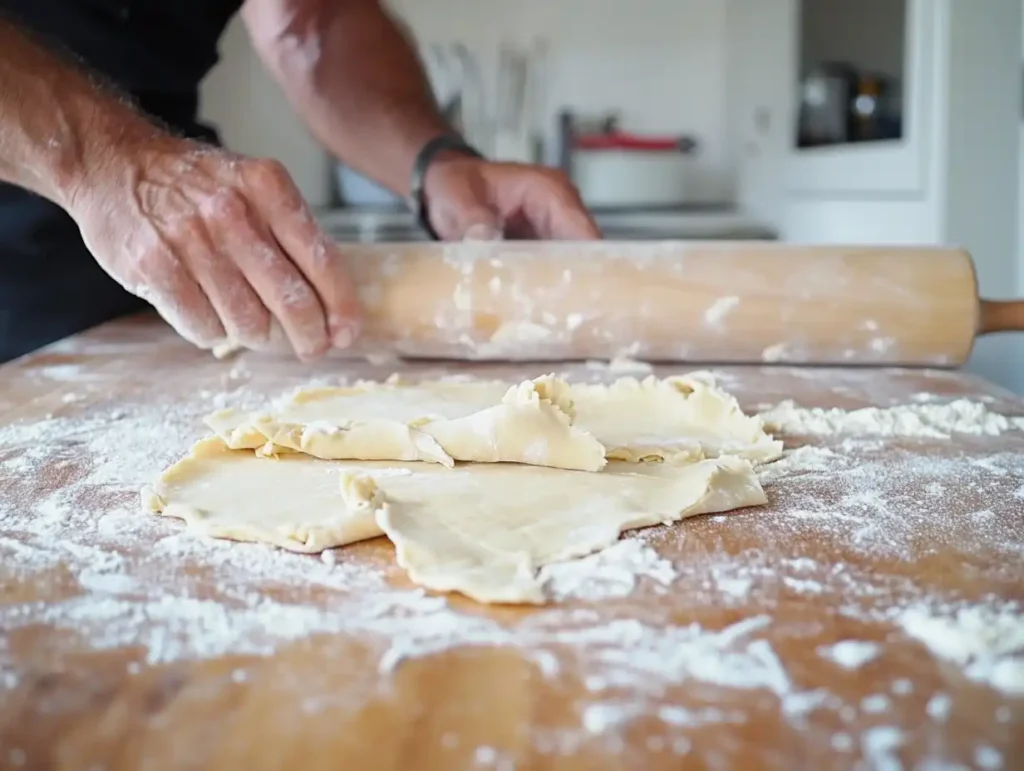
Adding Egg Wash for a Golden Finish
- Why Use Egg Wash: An egg wash (a mixture of beaten egg and water or milk) adds a glossy, golden finish to puff pastry, enhancing its visual appeal and flavor.
- How to Apply: Lightly brush the surface of the pastry with egg wash using a soft pastry brush. Avoid letting the egg wash drip onto the edges, as this can seal the layers and inhibit puffing.
- Variations: For a sweeter touch, sprinkle sugar over the egg wash before baking. For savory dishes, a pinch of salt or herbs can be added to the wash.
Preventing Soggy Bottoms
- Avoid Excessive Moisture: Wet fillings can make puff pastry soggy, especially at the base.
- Tip: Drain excess liquid from fillings like fruits or vegetables before assembling your dish.
- Preheat the Baking Surface: Placing puff pastry on a hot baking sheet or a preheated pizza stone can help create a crisp bottom crust.
- Ventilation: Cut small slits in the top of the pastry for steam to escape, reducing trapped moisture.
By avoiding common mistakes and incorporating these tips, you can elevate your puff pastry creations, ensuring they are perfectly baked, visually stunning, and deliciously flaky every time.
FAQs:
Can You Cook Puff Pastry at a Lower Temperature?
Yes, you can cook puff pastry at a lower temperature, but it may not yield the best results. Baking at temperatures below 375°F (190°C) can prevent the pastry from puffing properly, as the steam needed to create layers won’t form quickly enough. This can result in a denser texture and less flaky layers. If you must bake at a lower temperature, extend the cooking time and monitor closely to avoid undercooking.
What Happens if You Bake Puff Pastry Too Hot?
Baking puff pastry at excessively high temperatures (above 425°F or 220°C) can cause several issues:
- The outer layers may brown or burn too quickly, leaving the inside undercooked.
- The butter layers may melt too fast, resulting in uneven puffing or greasy pastry. To avoid this, follow the recipe’s recommended temperature and consider reducing the heat slightly if you notice over-browning.
Can You Reheat Puff Pastry, and at What Temperature?
Yes, puff pastry can be reheated to restore its crispness and warmth. The best method is to use an oven or toaster oven:
- Temperature for Reheating: Set the oven to 350°F (175°C) and heat the pastry for 5-10 minutes, depending on its size and thickness.
- Avoid microwaving puff pastry, as it tends to become soggy rather than crisp.
How Long Should Puff Pastry Be Cooked at 375°F?
When baking puff pastry at 375°F (190°C), the cooking time depends on the size and type of the pastry:
- Small pastries (e.g., turnovers): 20-25 minutes
- Larger items (e.g., pies or tarts): 30-40 minutes Always look for visual cues like a golden-brown color and fully puffed layers to determine doneness.
Do All Puff Pastry Brands Have the Same Ideal Baking Temperature?
Not all puff pastry brands have the same ideal baking temperature. Differences in recipes, ingredients, and thickness can influence baking recommendations. Always check the packaging instructions for brand-specific guidance. As a general rule, most puff pastries bake best between 375°F to 425°F (190°C to 220°C). Adjust based on your recipe and personal oven performance for optimal results.
Conclusion :Mastering the Art of Cooking Puff Pastry at the Right Temperature
Recap of Key Points
Cooking puff pastry at the right temperature is essential to achieving its signature flaky layers and golden-brown finish. Key takeaways include:
- Ideal Temperature Range: Bake puff pastry at 375°F to 425°F (190°C to 220°C) for the best results, with adjustments based on the recipe, filling, and oven type.
- Preheating is Crucial: Always preheat your oven to ensure consistent heat and proper puffing.
- Common Challenges: Avoid under-baking, over-baking, or soggy bottoms by monitoring the baking process, using appropriate techniques, and adjusting temperature or time as needed.
- Enhancements: Techniques like adding an egg wash or preheating the baking sheet can elevate both the appearance and texture of your puff pastry creations.
Encouragement to Experiment and Customize
While mastering the basics of baking puff pastry is essential, don’t be afraid to experiment and adapt. Each oven, recipe, and filling offers unique opportunities to customize and refine your approach. Whether you’re crafting a savory pie or a sweet dessert, the key is to stay attentive, patient, and creative.
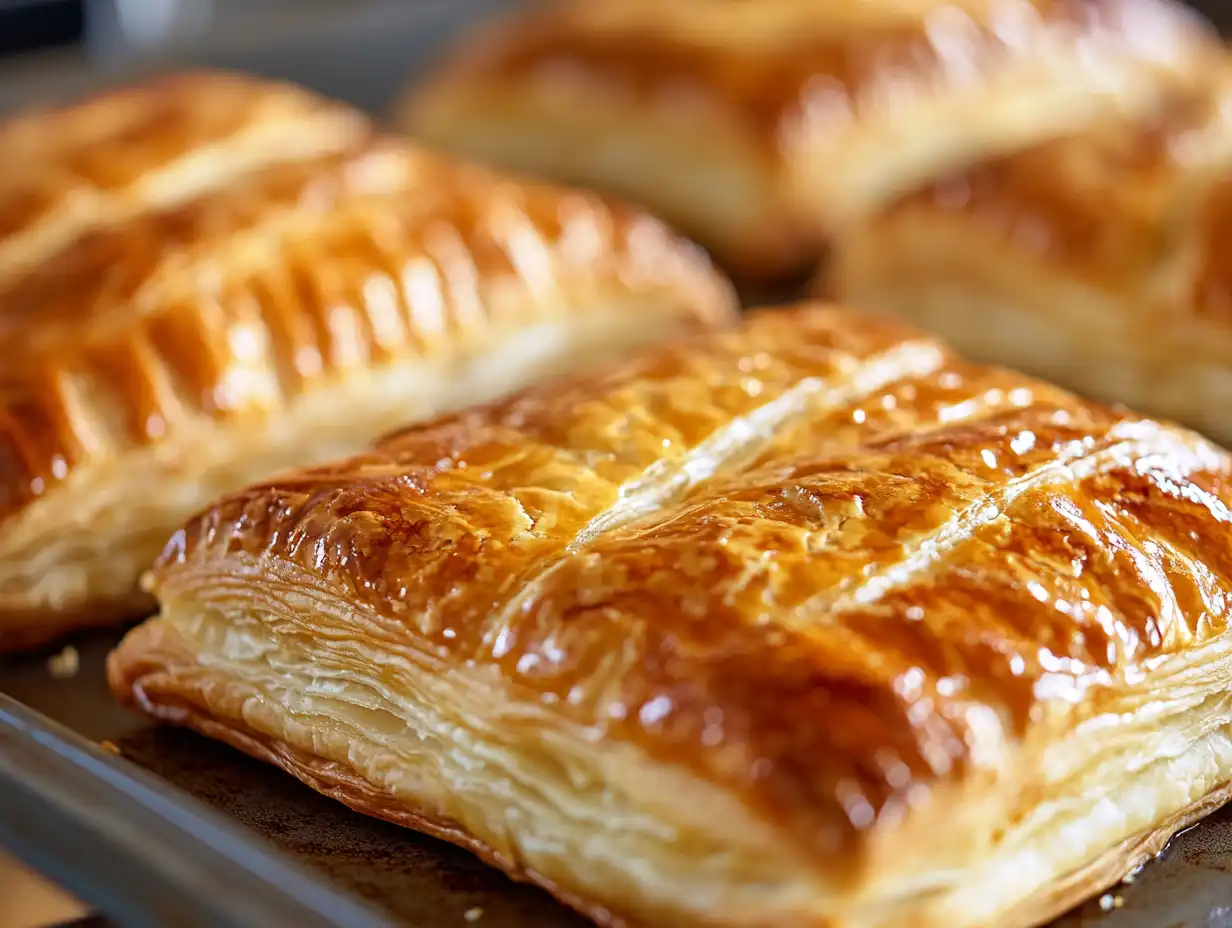
What Temperature to Cook Puff Pastry? The Ultimate Guide for Perfect Results
Ingredients
For the Dough:
- 2 ½ cups 315g all-purpose flour, sifted
- 1 teaspoon salt
- 1 cup 230g unsalted butter, cold and cubed
- ¾ cup 180ml cold water
- 1 teaspoon lemon juice optional, for flakiness
For Egg Wash (Optional):
- 1 egg yolk
- 1 tablespoon milk or water
Instructions
Step 1: Prepare the Dough
- In a large bowl, whisk together flour and salt.
- Add the cold cubed butter, tossing it in the flour to coat.
- Slowly pour in cold water and lemon juice while mixing with a wooden spoon until the dough starts to come together.
- Transfer to a floured surface and gently knead for 1-2 minutes until smooth.
- Shape into a rectangle, wrap in plastic, and refrigerate for 30 minutes.
Step 2: Laminate the Dough (Creating Layers)
- Roll the chilled dough into a 12×8-inch rectangle.
- Fold the dough into thirds, like a letter. Turn it 90 degrees and roll it out again.
- Repeat this folding and rolling process four more times to create flaky layers.
- Wrap the dough in plastic and refrigerate for at least 1 hour before using.
Step 3: Baking the Puff Pastry
- Preheat your oven to 400°F (200°C) and line a baking sheet with parchment paper.
- Roll out the dough to your desired thickness and cut into shapes as needed.
- Brush the surface with egg wash for a golden-brown finish.
- Bake for 20-25 minutes until puffed and golden brown.
- Cool slightly before serving. Enjoy!


